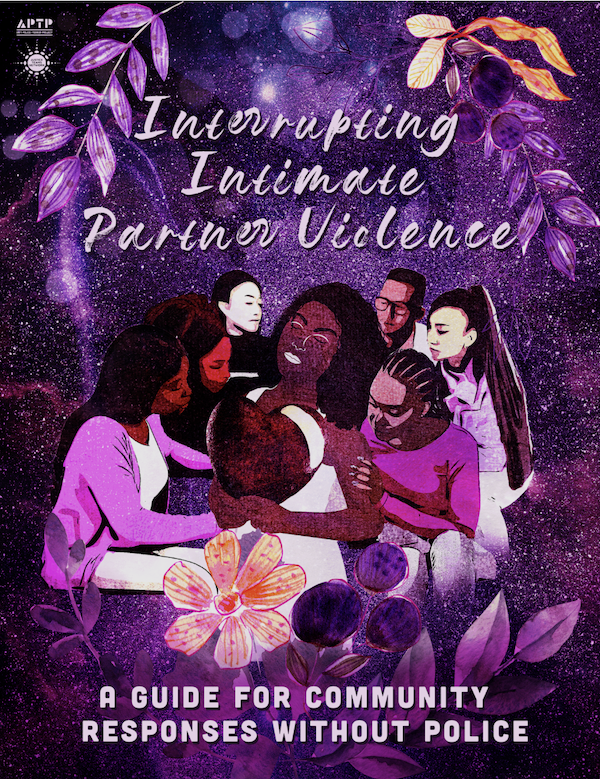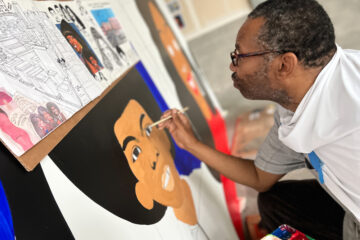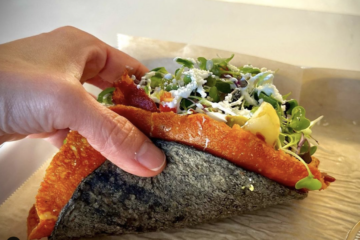How to Interrupt Domestic Violence Without Involving the Police

Photo by Volkan Olmez on Unsplash
By Cat Brooks executive director of the Anti Police-Terror Project & Justice Teams Network.
Today, In America, 3 women will be killed by their partners.
Every year nearly 5.3 million incidents of Intimate Partner Violence occur among U.S. women aged 18 and older resulting in 1300 deaths and 2 million injuries.
During the COVID 19 Pandemic – incidents of Intimate Partner Violence rose by 8% nationally. Not only did the numbers rise, but so did the intensity of the violence and numbers of hospitalizations and deaths. The holidays will compound and increase these numbers as every year, the two weeks between Christmas and New Years see spikes of IPV in homes across the country.
For over 40 years, our nation’s primary response to IPV has been police and prisons and for over 40 years, women have continued to die.
It’s time to do something else.
In October, during Domestic Violence Awareness month, the Anti Police-Terror Project (APTP) released our toolkit on non carceral response to Intimate Partner Violence.
Read and download the toolkit right here
APTP was birthed 13 years ago to eradicate state violence in communities of color. “All violence is state violence” because it is the state that creates the conditions for all of it to occur.
Poverty, trauma, stress, hunger, miseducation, white supremacy, race based capitalism, misogyny. These are the bedrocks of American society. It is no wonder we are one of the most violent countries in the world.
APTP exists to not just react to state violence but to stop it from happening in the first place. One way we have set about doing that is developing models of community response to community crisis that do not lead with law enforcement.
Two years ago, we launched Mental Health First (Oakland and Sacramento’s only non 9-1-1 response to mental health crises). Phase two of this work is non carceral response to Intimate Partner Violence.
The political is personal. The personal is political.

Read and download the guide right here.
I am a survivor of multiple partnerships that were plagued with violence and I am also a survivor of state intervention into that violence.
Like most Black people, I grew up with a sense of cognitive dissonance about police. On the one hand, I was spoon fed the narrative that the police kept me safe. On the other hand, I grew up watching them pull over, harass and harm my father – a Black man in the deserts of segregated Las Vegas who struggled with substance abuse.
I also grew up with a force of nature for a mother who was on the frontlines of the fight to end domestic violence. She was one of the foremothers of this movement and she, like many of her tribe at that time, fought like hell to get law enforcement to take DV seriously, to stop telling men to “cool off” with a “walk around the block”, for there to be consequences for dead women’s bodies.
I grew up believing police and prisons were how you dealt with batterers.
In 1992, I met my first husband in the rooms of a 12-step program. He was 28 and my sponsor’s boyfriend. I was 17 and thought I was in love. The verbal abuse started first. A slow wearing down of my confidence. When I was 19, we married and the real violence began. One night, I came home from rehearsal late. The next thing I knew I laid on the floor bloody and bruised. I heard him make a call. “My wife has attacked me and I need the police.” He was white. I was Black. Two white police officers arrived. I was bloody and bruised. The cops decided that I was the primary aggressor. Off to jail I went. The D.A. tried to throw the book at me. But my abuser wasn’t done with me yet. In court, he admitted he had done the abusing. He wanted me home, not in jail. Case dismissed.
I learned a valuable lesson. Like thousands of other battered women of color have learned: The police made things worse and had the potential to be just as violent and potentially more deadly than my abuser.
This incident became part of the bedrock of my political work to build alternative responses to community crises.
I am an abolitionist. My work is largely focused on dismantling the carceral systems in this country. That does not mean that I do not believe in accountability or consequences. It means that, like any of you, I want to live in thriving, safe communities and that I believe the way we do public safety in this country does a very poor job of keeping us safe.
We will never interrupt violence and trauma by putting people who learned to express their trauma through violence into the most violent institutions in the world for “rehabilitation”.
I learned a valuable lesson. Like thousands of other battered women of color have learned: The police made things worse and had the potential to be just as violent and potentially more deadly than my abuser.
The answer to healing ourselves, families and communities has nothing to do with the carceral state and everything to do with addressing the trauma, pain, and suffering of all parties involved.
A 2022 survey by the National Domestic Violence Hotline found that among survivors who had called police, 39% said they felt less safe after calling, and 40% stated that it made no difference in their safety.
Among survivors who did not call the police, 92% were afraid or concerned about how the police would react.
For many of us, law enforcement is simply not an option. Many of us do not want our families broken up or the person causing harm to be harmed themselves. We just want the violence to stop. And unlike the state, we believe these people we love have the capacity to change – if only they had the right resources.
Those closest to the pain, are closest to the solution.
APTP’s model is based on three years of conversation, research and deep listening to survivors.
Key principles to community IPV response must include:
- Local, Local, Local! A community first model should launch at the neighborhood level, or even block by block. It could be situated within your place of worship, community clinic, or resident safehouse.
- Broad community involvement and ownership. A successful community-first model should engage other advocates, such as the immigrants’ rights community, the faith community, homeless advocates and others who may already be intervening without police and be positioned to help.
- Survivor-Centeredness and Self-determination. The survivor must be the one who calls the shots.
- Safety. Responding to any form of violence involves an inherent degree of risk, and civilian first responders must recognize and assess the risk of any given situation. Community-first response to IPV must include safety and de-escalation training for the responder team.
- Culturally rooted and appropriate. First responders must be culturally competent and strive to include members from a given community when planning an intervention.
- Whole Family Interventions. Interventions that consider the family as a whole entity can be effective and position the survivor and their family (if they wish) to begin to address the trauma that likely exists among all members of the family, including the person who has committed the violence.
- Strong Network of Referrals for Ongoing Support. Any community intervention will need to have a strong network of referrals and resources to point families towards for ongoing support.
- Relationships Matter. Responding to IPV requires strong relationships and trust. Building these relationships — with your neighbors, service providers, referral agencies ect., is critical to building a community response.
- Law Enforcement Must be the Last Resort. It may not be possible to avoid law enforcement involvement in every situation, but this should only occur as a last resort when the survivor deems it absolutely necessary and has given explicit, informed consent.
- Intersectionality. Intersectionality is a core principle of our work and should be a key consideration of any intervention. The term was coined by law professor and critical race theorist Kimberly Crenshaw, who wrote: “Intersectionality is a lens through which you can see where power comes and collides, where it interlocks and intersects. It’s not simply that there’s a race problem here, a gender problem here, and a class or LBGTQ problem there. Many times that framework erases what happens to people who are subject to all of these things.”
- Abolition and Transformative Justice. Alternative models of conflict resolution and accountability should challenge existing systems. Our goal is to set up autonomous alternatives based on accountability, and compassion that challenge the treatment of people who are criminalized.
- Healing Justice. Healing Justice is a framework that identifies how we can holistically respond to and intervene on intergenerational trauma and violence, and to bring collective practices that can impact and transform the consequences of oppression on our collective bodies, hearts and minds.
- Disability Justice. Disability Justice seeks to challenge radical and progressive movements to more fully address ableism by recognizing the intersecting legacies of white supremacy, colonial capitalism, gendered oppression and ableism in understanding how people’s’ bodies and minds are labeled ‘deviant’, ‘unproductive’, ‘disposable’ and/or ‘invalid’
The United States incarcerates more people than any other country on the planet and more than all the other “developed” countries combined. If we could incarcerate our way out of America’s violence, we would be the safest country in the world.
Like cops. Don’t like cops. This is not about individual officers but rather an institution born out of chattel slavery and the calvaries that continue to drown in violence.
Believe in jails and prisons as they currently exist or don’t. The facts. The data. Our lived experience tells us unequivocally that the carceral state doesn’t do what it purports to do.

Photo by Sydney Sims on Unsplash
40 plus years of leaning on the state for the primary response – let alone an intervention – to ending domestic violence just hasn’t done what our foremothers thought it would. What many of us every day continue to hope it will.
God bless my mother and the foremothers of our movement to end violence. They were not all “carceral feminists” and not all of them simply ignored the warnings of women of color. Though to be clear, lots did…and too many of y’all “woke” ones still do.
Some of our foremothers just had tunnel vision, driven by desperation, dead women, their own traumatic histories and a fierce commitment to ending violence against our bodies and in our homes. At a time when women had little-to-no protection under the law, it makes sense that their number one demand was that the police do what at least they espouse their job to be: Protect & Serve. In their time, protection meant removal and serving meant jail years.
They did the best they could with what they had and what they knew. And now, we who continue the work, know better, so we must honor their work, their struggle, their sacrifice and their lives by doing better. By listening to survivors, by following their lead, by demanding investment in not just carceral responses but also – mostly – into mental health supports, housing for women and children, training for living wage jobs, safe houses for women who need to separate, healing and transformative justice practices for causers of harm, wrapping our arms around the entire family. We demand investment in things that will actually put a dent in the daily violence we face. Investment in something that actually works.
Cat Brooks is the executive director of the Anti Police-Terror Project & Justice Teams Network. She is an award-winning actress, playwright and director and the host of Law & Disorder on KPFA. She lives in West Oakland with her daughter.









